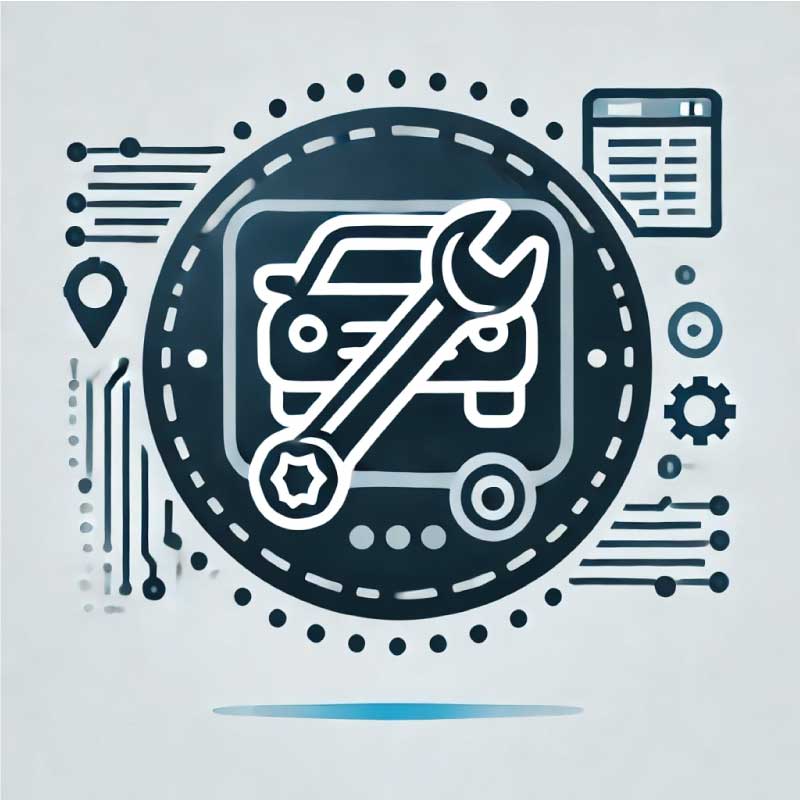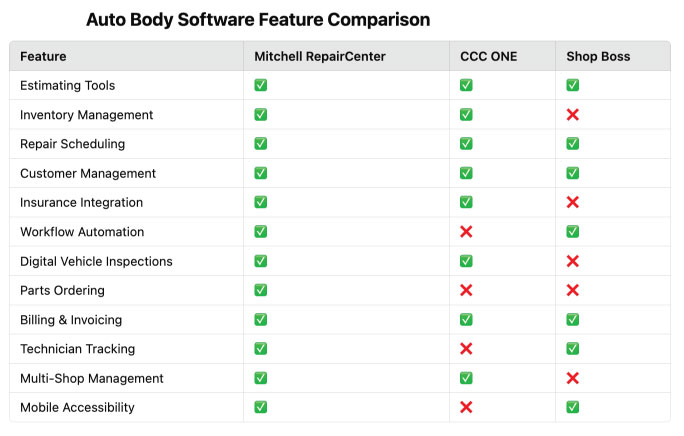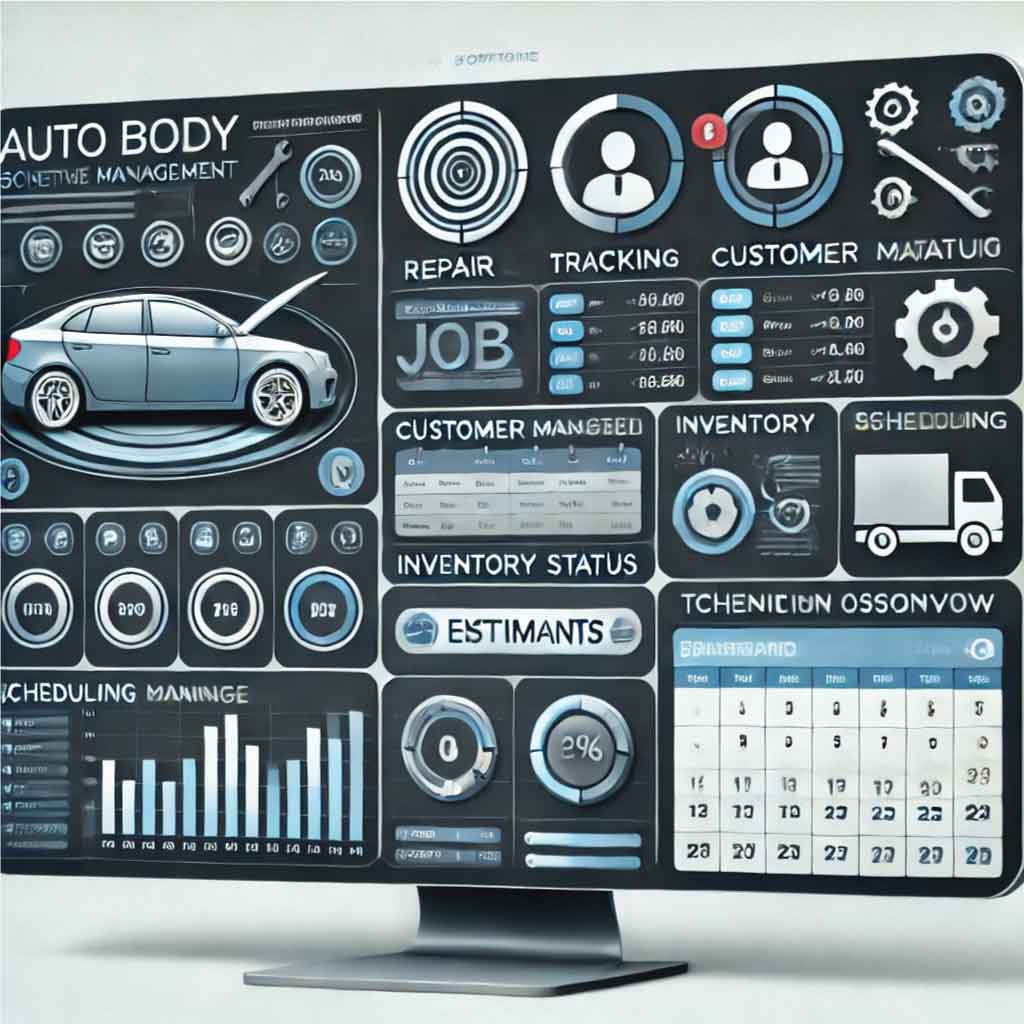Auto body software is designed to help auto repair shops streamline operations, from estimating repairs to managing inventory, scheduling jobs, and handling customer relations. These tools are essential for collision repair centers, body shops, and service garages that need efficient workflow management.
Leading software solutions in this category include Mitchell RepairCenter, CCC ONE, Shop Boss, BodyShop Booster, and Nexsyis Collision. Many solutions also integrate with accounting software, customer relationship management (CRM) tools, and insurance processing systems.
Related software categories include Auto Repair Software, Fleet Maintenance Software, and Automotive CRM Software.

Mitchell RepairCenter – A comprehensive solution offering estimating, workflow automation, and insurance integration for auto body shops.
CCC ONE – A widely used platform specializing in insurance claims management, customer communication, and digital repair estimates.
Shop Boss – A cloud-based auto repair software designed for both mechanical and body shops, featuring invoicing and technician tracking.
BodyShop Booster – Focused on customer communication, this software enhances appointment scheduling and CRM functions.
Nexsyis Collision – A fully integrated business management system for multi-shop operators, with financial tracking and reporting features.
ProDemand – Provides access to OEM repair procedures and labor estimates to ensure precise and compliant repairs.
GEM-CAR – A versatile auto repair management software with estimating, invoicing, and parts tracking tools.
Autobody Management Solutions (ABMS) – Specializes in shop workflow automation, digital inspections, and job tracking.
The table below compares three leading auto body software solutions: Mitchell RepairCenter, CCC ONE, and Shop Boss. These platforms offer various features to streamline shop operations, improve repair efficiency, and enhance customer communication.

This feature comparison table highlights key differences between Mitchell RepairCenter, CCC ONE, and Shop Boss, ensuring no two solutions offer identical feature sets. Mitchell RepairCenter stands out as the most feature-complete option, providing robust workflow automation, multi-shop management, and parts ordering, making it ideal for large-scale operations. CCC ONE excels in estimating, insurance integration, and customer management, but lacks workflow automation, technician tracking, and mobile accessibility, which may be limiting for some shops. Shop Boss is a strong contender for general repair shop management, offering billing, scheduling, and technician tracking, but falls short in insurance handling, inventory management, and multi-shop support. This breakdown helps repair shops select software that best matches their workflow priorities.
Running an auto body shop efficiently requires more than just skilled technicians—it takes smart management and streamlined scheduling to keep repairs on track and customers satisfied. In this video, you’ll discover the key benefits of using auto body shop management and scheduling software, including automated repair estimates, real-time job tracking, inventory management, and seamless customer communication. Whether you’re looking to boost productivity, reduce downtime, or improve your shop’s profitability, this video breaks down how the right software can transform your operations. Watch now to see how technology can take your auto body shop to the next level!
This example auto body software dashboard is designed to streamline shop operations with a clear and organized interface. At the center, a repair job tracking panel displays active repairs, technician assignments, and estimated completion times, helping shops stay on schedule. Integrated customer management tools store service history and appointments, ensuring smooth communication and repeat business.
Additional features include an inventory tracker for monitoring parts availability, a scheduling calendar for managing technician workloads, and a billing overview to track invoices and payments. Quick-access icons provide easy navigation to essential tools like estimating, parts ordering, and workflow automation, making the dashboard a powerful tool for improving efficiency and organization in any auto body shop.

Auto body software solutions provide end-to-end management for body shops, ensuring efficient repair processes, accurate cost estimation, and seamless communication with customers and insurance companies. These tools are designed to reduce downtime, improve productivity, and enhance customer satisfaction. Below, we explore the core features that make auto body software an essential tool for modern repair shops.
Estimating Tools
Auto body software includes built-in estimating tools that allow shops to quickly assess damages and generate accurate repair estimates. These tools integrate labor rates, parts costs, and industry-standard repair procedures to ensure precise calculations.
Inventory Management
Keeping track of parts and materials is crucial for a body shop. Inventory management tools help monitor stock levels, automate reordering, and track usage to prevent shortages or overstocking.
Repair Scheduling
With integrated calendars and scheduling features, shops can efficiently assign repair jobs to technicians, manage workloads, and provide customers with accurate repair timelines.
Customer Management
Auto body software includes CRM features that store customer information, track service history, and send appointment reminders, ensuring better communication and retention.
Insurance Integration
Many solutions connect directly with insurance companies to process claims, submit repair estimates, and receive approvals, making the insurance handling process smoother.
Workflow Automation
From check-in to final billing, workflow automation tools optimize shop processes by reducing manual tasks, improving efficiency, and minimizing errors.
Digital Vehicle Inspections
Digital inspections allow technicians to document damages with photos and notes, providing customers and insurers with a clear understanding of necessary repairs.
Parts Ordering
Shops can order parts directly from suppliers through the software, ensuring faster repair times and eliminating the risk of ordering incorrect components.
Billing & Invoicing
Automated billing and invoicing tools help generate accurate invoices, process payments, and integrate with accounting software to simplify financial management.
Technician Tracking
Managers can track technician performance, monitor assigned tasks, and measure productivity to optimize workflow and efficiency.
Multi-Shop Management
For businesses operating multiple locations, this feature enables centralized management of all shops, including inventory, staff assignments, and financials.
Mobile Accessibility
Many modern solutions offer mobile apps or cloud-based access, allowing shop owners and technicians to stay connected and manage operations remotely.
It helps collision repair shops manage estimates, inventory, repairs, and customer interactions.
Yes, many solutions allow direct communication with insurers for claims processing.
Many cloud-based platforms offer mobile apps or web access for remote management.
Yes, passwordless authentication eliminates password-related vulnerabilities, reducing the risk of phishing and credential theft.
Yes, it allows shop managers to monitor technician workloads and productivity.
These are electronic inspections that include photos and notes to document vehicle conditions.
Some platforms connect directly with suppliers, allowing for seamless part procurement.
Most premium solutions include automation to streamline shop operations.
Some platforms support multiple locations with centralized management features.
It automates invoice generation, payment processing, and financial reporting.